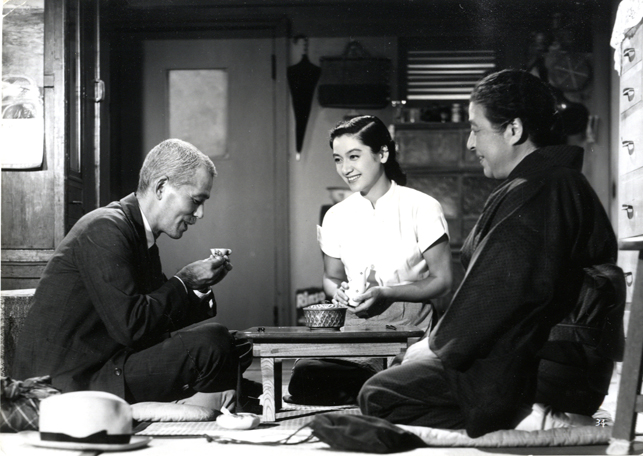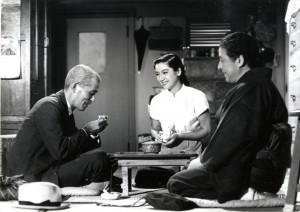
Written by Yasujiro Ozu and Kogo Noda
Directed by Yasujiro Ozu
Japan, 1953
December 12 marks 110 years since the birth of the great Japanese master Yasujiro Ozu (and 50 years to the date since his death). So what better way to commemorate the occasion than to revisit what is widely seen as his masterpiece among masterpieces, Tokyo Story, out now on a 3-disc dual format Blu-ray/DVD from The Criterion Collection? There have been few filmmakers treated as well by Criterion as Ozu, with more than a dozen titles available either as standalone discs or as part of a set. This latest edition of Tokyo Story, an update on their DVD release from 2003, is no exception.
The film looks spectacular in its new digital restoration, the sharpness making even more clear the attention to detail Ozu devoted to his compositions; sides, foregrounds, and backgrounds are all layered with authentic texture and icons of Japanese culture and Ozu’s distinct cinema. The disc includes a 1988 documentary about long-time Ozu actor and general staple of Japanese film, Chishu Ryu, as well as a revised essay by esteemed professor and author David Bordwell (“Ozu and the Poetics of Cinema”). Ryu, whose first of 213 roles was in Ozu’s early Pumpkin from 1928, is crucial to Japanese cinema generally and to Ozu specifically (he is featured in 52 of the director’s 54 films). The attention given to him in the documentary is well deserved and does much to highlight this performer who saw Japanese filmmaking go through every conceivable transition, from silent to sound, from black and white to color, pre- and post-war. As per the norm with his writing, Bordwell’s essay is insightful, concise, enthusiastic, and free of the pretentious jargon utilized by many academics when dealing with Ozu’s aesthetics. Updated for this Blu-ray release, the essay also allows Bordwell to point out the 2012 Sight & Sound poll that placed Tokyo Story as the third greatest film ever made.
Carried over from the previous edition are a commentary track by David Desser, editor of “Ozu’s ‘Tokyo Story;'” and Talking with Ozu, a tribute to the director, featuring seven filmmakers ranging from Wim Wenders, who made his own documentary about Ozu, Tokyo-ga, included on Criterion’s Late Spring disc, to Paul Schrader, whose “Transcendental Style In Film” is an essential film text looking at Ozu, Robert Bresson, and Carl Dreyer. Made to coincide with the anniversary of Ozu’s birth and death in 1993, Talking with Ozu is comprised of highly personal accounts about the director’s impact on the careers of those featured. Some become quite emotional (Stanley Kwan) and some approach Ozu’s influence with humor (Aki Kaurismäki), but all reveal the breadth of Ozu’s international reach. Wenders points out that, “Family throughout the world has become imaginable and understandable only through Ozu’s films,” and Hou Hsiao-hsien compares Ozu to a “mathematician” insofar as the way he analyzed Japanese people in a detached way. The documentary also contains some fascinating and rarely seen footage of Ozu on set directing.
The real treasure on the disc is I Lived, But . . . , a 2-hour documentary from 1983 about Ozu’s life and career. It alone is worth the price of purchase. This inclusion is abundant with biographical details, professional recollections, and critical reevaluations, many of which shed new and revealing light on where Ozu came from (it’s noted that he first became interested in filmmaking after seeing the 1916 Thomas Ince feature Civilization), and why and how he did what he did with his films. It covers nearly all of his major works and includes clips from most, including many now since lost or at least not readily available. In it, the narrator sets the scene by noting that some directors focus on “raging torrents,” while others, like Ozu, instead turn their cameras on “calmer waters.” Ozu gets to the crux of his filmmaking: “Rather than tell a superficial story, I wanted to go deeper, to show the hidden undercurrents, the ever-changing uncertainties of life.” With that, there is then the film at hand.
Tokyo Story was one of Ozu’s later films, his output steadily slowing by this point — there would only be eight films after. With frequent co-writer and drinking buddy Kogo Noda (they would judge their writing progress by the empty bottles of sake around them), and as was his tendency, Ozu would focus on an average, contemporary middle class family, emblematic of the Gendai-geki genre of Japanese film that he would almost exclusively favor. Within that, he would examine, most prominently, the eternal struggles between young and old, parents and children, single living and the institution of marriage, individual wants and familial responsibility. This focus could be seen as ironic; Desser notes in his commentary that Ozu never married nor had children. But in the banal realities of ordinary existence, Ozu continually found drama, sadness, and humor, all in the “nuances of everyday life,” as Desser puts it. While some of his earlier films were slightly more varied in their subject matter, this was to be the typical point of consideration in most of Ozu’s work.
Not unlike the basic narrative of Leo McCarey’s Make Way for Tomorrow, Tokyo Story is primarily concerned with an elderly couple, Shukichi and Tomi Hirayama (Ryu and Chieko Higashiyama), as they find themselves alienated and emotionally distanced from their grown children. Leaving youngest daughter Kyoko (Kyoko Kagawa) at home in Onomichi, the two visit Tokyo where they plan to spend some time with son Koichi (So Yamamura) and his wife and children, and daughter Shige (Haruko Sugimura) and her husband. Neither family, however, is particularly welcoming to the parents and they quickly view the visitors as burdensome and annoying. The children neglect and dismiss Shukichi and Tomi, while the elders reflect on the high hopes they had for their children and whether or not they’ve been met. The exception is widowed daughter-in-law Noriko (Setsuko Hara – as always, breathtaking), who is genuinely and warmly receptive to the parents of her dead husband. On the return trip to Onomichi, Tomi falls ill. After a brief stop in Osaka, where they reunite with the even more negligent son Keizo (Shiro Osaka), the couple makes it back home, where Tomi’s health takes a further turn for the worse. In this basic narrative are moments of tremendous depth and poignant resonance, Ozu hitting on universal ideas and feelings that no doubt contribute to Tokyo Story’s wide appeal and acclaim. “Isn’t life disappointing?” asks Kyoko. “Yes,” responds Noriko with a smile, “it is.” This sort of quiet resignation of life’s ups and downs is crucial to Ozu’s work, here and elsewhere. It’s not as melodramatic as McCarey’s film, but its emotional cues and moments of overt sentiment are more pronounced than in some of Ozu’s other features. It’s perhaps this careful balance that distinguishes Tokyo Story as the filmmaker’s most enduringly popular.
Two things are instantly apparent in terms of Ozu’s distinct style, and they’re both prominently on display here. The first is the filmmaker’s choice in camera placement, frequently at an uncommonly low angle, about even with the vantage point of someone sitting on the floor. Some argue that this position is indeed based on this sitting position, reflecting the sight of an individual on a tatami mat, for instance. In I Lived, But . . ., director Kaneto Shindo argues that Ozu “didn’t use low-angle shots just for style.” He says, “Ozu got to the heart of Japan” with this approach: ordinary people in typically Japanese settings. The constant presence of shoji screens, futon pallets, and tatami mats all form straight lines and right angles. “He confined living beings within these rigid forms,” states Shindo. For the interiors of his films, this is reasonable enough; when inside, his characters are usually sitting down and the architecture and set design lends itself to this sense of rigorous character placement and unspectacular though revealing action. There is also the fact that such a low angle, especially kept in a wider shot, presents more of a given room, and much of Ozu’s visual design is concerned with geometric patterns, of lines and depictions of interior space. But why does he maintain this angle when scenes are outside, such as in an alleyway or along a street? A theory that possibly carries the most weight is that this position best illustrates a sense of balance, of order. It’s a stationary arrangement that puts the spectator at a stable position reflecting objectivity and poise, all contributing to an equilibrium stressing Ozu’s preoccupations with contemplation and calm solemnity.
The second feature instantly noticeable are his transitions between scenes. Rather than dissolves or fades to black, we’re brought via straight cuts to the next sequence of events. Ozu incorporates something unique. When one of his scenes ends, before the next properly begins, we are commonly held back from the narrative through seemingly innocuous shots of buildings glistening in the sunlight, of factory smokestacks, of vacant rooms, of clothes hanging on the line. These “pillow shots,” as they’re sometimes known (Desser refers to them as “intermediate spaces”), don’t simply bring us to the next scene, they bring us further into the time and place of each story, giving Ozu’s films a marked sense of captured documentary realism. They are pauses in the drama that orient us not so much in the narrative progress, but in the world of the film. They are brief moments of reflection, extraneous to the apparent “action” of the film. These are sequences in opposition to our normal sense of simply “getting on with it.” When American audiences were devouring the action-packed samurai epics of Akira Kurosawa in the 1950s (films equally great in their own right), Ozu was at the time seen as being too reserved, too traditional, “too Japanese.” Now, these moments of meditative restraint can come as a relief from the current sensory bombardment in film.
Do these stylistic characteristics alone make Ozu great? Certainly not. But they do attribute to him a distinct formal technique and a distinguishing tone. He is a singular artist in the cinema, and each of his films are notably his and his alone. Their visual and thematic consistency can cause some to decry him for having made the same film over and over again (some similar titles can also add to this verdict), but within such standard formal patterns, Ozu conveys remarkable differences from film to film. Desser points out that Ozu considered himself a craftsman, or something akin to a tofu maker; he made one kind of film, but he did it exceedingly well with great care. If that is indeed the case, Tokyo Story may be his finest product.
— Jeremy Carr



